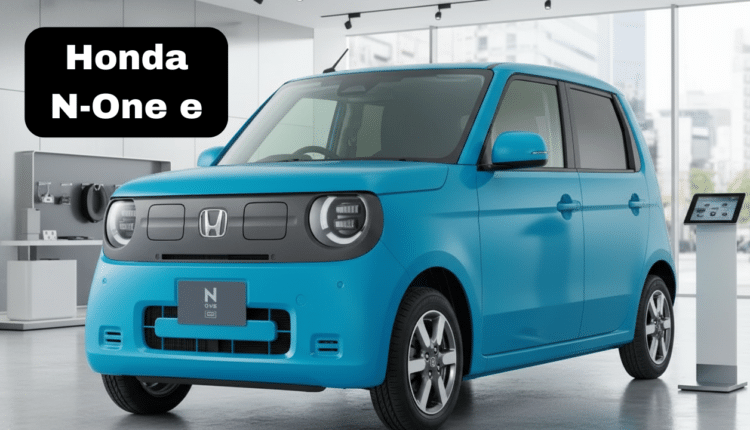Honda N-One e: A Bold Move to Challenge Japan’s EV Market
Japan’s electric vehicle (EV) market is heating up, and Honda is determined to make a strong impact with its newly launched Honda N-One e. The compact electric kei car made its debut recently, aiming to compete directly with Japan’s best-selling EV, the Nissan Sakura. The N-One has long been a familiar name in Japan’s kei car segment, but this marks its first-ever electric variant, giving it a fresh identity and improved performance to stand out in a crowded field.
Honda N-One e Offers Impressive Specs for a Kei Car
The Honda N-One e brings more than just a new badge to the table. It has been reimagined with a distinct design and a powertrain that makes it one of the most efficient small electric vehicles available.
Key features of the Honda N-One e include:
- Battery Capacity: A 29.3 kWh battery pack, which delivers a WLTP-certified range of 183 miles (295 km), impressive for a kei car’s footprint.
- Charging Capabilities:
- 6 kW onboard AC charger, fully charging in 4.5 hours.
- 50 kW DC fast charger reaches 80% capacity in about 30 minutes.
- Power Output: 64 horsepower – enough to give the car lively city performance without feeling underpowered.
- Design Changes:
- Boxier front fascia and squared-off rear for a unique electric identity.
- Slim battery architecture that doesn’t compromise interior space.
- Steering wheel moved 1.5 inches closer to improve ergonomics.
The range alone places it in competition with larger models like the BYD Seagull, Hyundai Inster, and Renault 5 E-Tech. Meanwhile, the Nissan Sakura offers only 20 kWh and about 110 miles (180 km) of range, making the N-One e a clear frontrunner in terms of distance.
Unique Features That Set Honda N-One e Apart
What really makes the Honda N-One e stand out is its versatility. The vehicle isn’t just a commuter tool—it’s also a backup power source and lifestyle enabler.
Bidirectional Charging Technology
- Vehicle-to-Load (V2L) and Vehicle-to-Home (V2H) functionality allows the N-One e to supply up to 1.5 kW of power to external devices or even homes.
- Acts as a backup energy source during power outages.
- Enables users to charge at night when electricity rates are lower and use stored power during peak hours, helping reduce household energy costs.
This integration of smart charging positions the N-One e as more than just a transport option—it’s a practical tool for modern life.
Space Efficiency and Comfort
Unlike many electric conversions, Honda claims that turning the N-One into an EV hasn’t compromised its interior space. The slim battery layout ensures that foot space remains unaffected, and the improved driving posture adds to the comfort for daily commuting.
Market Focus and Expansion
The N-One e is exclusively designed for the Japanese market, where kei cars make up about 40% of new car sales. Its main competitor, the Nissan Sakura, has enjoyed popularity, but the N-One e offers better range, design, and utility.
Additionally, it will face competition from new entrants like BYD’s all-electric kei car—the first such vehicle from a non-Japanese manufacturer—signaling a growing and competitive EV landscape.
Global Aspirations: Honda’s Next Move
Honda isn’t stopping with Japan. A more rugged version of the N-One, featuring rally-inspired fenders and a wider track, is expected to be sold in Europe and other global markets. This version was previewed at the Goodwood Festival of Speed as the Honda Super EV Concept, signaling Honda’s intent to offer a sportier experience.
What Europe Needs
Honda’s first attempt at a subcompact EV, the Honda e, failed to gain traction mainly due to its high price tag. For the new N-One variant to succeed, especially in Europe, affordability must be a priority.
Models like the BYD Seagull, also known as the Dolphin Surf, are offering substantial range and features at lower prices, which sets a benchmark for the competition.
The upcoming N-One variant will need to balance performance, utility, and cost to meet the expectations of urban drivers across Europe.
Final Verdict
The Honda N-One e represents a bold and strategic entry into Japan’s electric kei car market. With its larger battery, impressive range, and innovative bidirectional charging technology, it’s well-positioned to challenge the current market leader, the Nissan Sakura. The focus on practicality, comfort, and energy management makes it a smart choice for city dwellers and eco-conscious drivers alike.
However, its future success will depend on how well Honda executes its global strategy. The Europe-bound version must be affordable while offering engaging performance. If Honda can strike the right balance between price and innovation, the N-One e could not only dominate Japan’s EV scene but also establish a strong presence in the global electric vehicle market.


